- 您現(xiàn)在的位置:買賣IC網 > PDF目錄4555 > DS3184 (Maxim Integrated Products)IC QUAD ATM/PACKET PHY 400-PBGA PDF資料下載
參數(shù)資料
| 型號: | DS3184 |
| 廠商: | Maxim Integrated Products |
| 文件頁數(shù): | 106/400頁 |
| 文件大?。?/td> | 0K |
| 描述: | IC QUAD ATM/PACKET PHY 400-PBGA |
| 產品培訓模塊: | Lead (SnPb) Finish for COTS Obsolescence Mitigation Program |
| 標準包裝: | 1 |
| 類型: | 調幀器 |
| 應用: | 數(shù)據傳輸 |
| 安裝類型: | 表面貼裝 |
| 封裝/外殼: | 400-BBGA |
| 供應商設備封裝: | 400-PBGA(27x27) |
| 包裝: | 管件 |
第1頁第2頁第3頁第4頁第5頁第6頁第7頁第8頁第9頁第10頁第11頁第12頁第13頁第14頁第15頁第16頁第17頁第18頁第19頁第20頁第21頁第22頁第23頁第24頁第25頁第26頁第27頁第28頁第29頁第30頁第31頁第32頁第33頁第34頁第35頁第36頁第37頁第38頁第39頁第40頁第41頁第42頁第43頁第44頁第45頁第46頁第47頁第48頁第49頁第50頁第51頁第52頁第53頁第54頁第55頁第56頁第57頁第58頁第59頁第60頁第61頁第62頁第63頁第64頁第65頁第66頁第67頁第68頁第69頁第70頁第71頁第72頁第73頁第74頁第75頁第76頁第77頁第78頁第79頁第80頁第81頁第82頁第83頁第84頁第85頁第86頁第87頁第88頁第89頁第90頁第91頁第92頁第93頁第94頁第95頁第96頁第97頁第98頁第99頁第100頁第101頁第102頁第103頁第104頁第105頁當前第106頁第107頁第108頁第109頁第110頁第111頁第112頁第113頁第114頁第115頁第116頁第117頁第118頁第119頁第120頁第121頁第122頁第123頁第124頁第125頁第126頁第127頁第128頁第129頁第130頁第131頁第132頁第133頁第134頁第135頁第136頁第137頁第138頁第139頁第140頁第141頁第142頁第143頁第144頁第145頁第146頁第147頁第148頁第149頁第150頁第151頁第152頁第153頁第154頁第155頁第156頁第157頁第158頁第159頁第160頁第161頁第162頁第163頁第164頁第165頁第166頁第167頁第168頁第169頁第170頁第171頁第172頁第173頁第174頁第175頁第176頁第177頁第178頁第179頁第180頁第181頁第182頁第183頁第184頁第185頁第186頁第187頁第188頁第189頁第190頁第191頁第192頁第193頁第194頁第195頁第196頁第197頁第198頁第199頁第200頁第201頁第202頁第203頁第204頁第205頁第206頁第207頁第208頁第209頁第210頁第211頁第212頁第213頁第214頁第215頁第216頁第217頁第218頁第219頁第220頁第221頁第222頁第223頁第224頁第225頁第226頁第227頁第228頁第229頁第230頁第231頁第232頁第233頁第234頁第235頁第236頁第237頁第238頁第239頁第240頁第241頁第242頁第243頁第244頁第245頁第246頁第247頁第248頁第249頁第250頁第251頁第252頁第253頁第254頁第255頁第256頁第257頁第258頁第259頁第260頁第261頁第262頁第263頁第264頁第265頁第266頁第267頁第268頁第269頁第270頁第271頁第272頁第273頁第274頁第275頁第276頁第277頁第278頁第279頁第280頁第281頁第282頁第283頁第284頁第285頁第286頁第287頁第288頁第289頁第290頁第291頁第292頁第293頁第294頁第295頁第296頁第297頁第298頁第299頁第300頁第301頁第302頁第303頁第304頁第305頁第306頁第307頁第308頁第309頁第310頁第311頁第312頁第313頁第314頁第315頁第316頁第317頁第318頁第319頁第320頁第321頁第322頁第323頁第324頁第325頁第326頁第327頁第328頁第329頁第330頁第331頁第332頁第333頁第334頁第335頁第336頁第337頁第338頁第339頁第340頁第341頁第342頁第343頁第344頁第345頁第346頁第347頁第348頁第349頁第350頁第351頁第352頁第353頁第354頁第355頁第356頁第357頁第358頁第359頁第360頁第361頁第362頁第363頁第364頁第365頁第366頁第367頁第368頁第369頁第370頁第371頁第372頁第373頁第374頁第375頁第376頁第377頁第378頁第379頁第380頁第381頁第382頁第383頁第384頁第385頁第386頁第387頁第388頁第389頁第390頁第391頁第392頁第393頁第394頁第395頁第396頁第397頁第398頁第399頁第400頁

DS3181/DS3182/DS3183/DS3184
194
Table 10-38. Pseudorandom Pattern Generation
BERT.PCR REGISTER
BERT.CR
PATTERN TYPE
PTF[4:0]
(hex)
PLF[4:0]
(hex)
PTS
QRSS
BERT.
PCR
BERT.
SPR2
BERT.
SPR1
TPIC,
RPIC
2
9-1 O.153 (511 type)
04
08
0
0x0408
0xFFFF
0
2
11-1 O.152 and O.153
(2047 type)
08
0A
0
0x080A
0xFFFF
0
2
15-1 O.151
0D
0E
0
0x0D0E
0xFFFF
1
2
20-1 O.153
10
13
0
0x1013
0xFFFF
0
2
20-1 O.151 QRSS
02
13
0
1
0x0253
0xFFFF
0
2
23-1 O.151
11
16
0
0x1116
0xFFFF
1
Table 10-39. Repetitive Pattern Generation
BERT.PCR REGISTER
PATTERN TYPE
PTF[4:0]
(hex)
PLF[4:0]
(hex)
PTS
QRSS
BERT.
PCR
BERT.
SPR2
BERT.
SPR1
all 1s
NA
00
1
0
0x0020
0xFFFF
all 0s
NA
00
1
0
0x0020
0xFFFF
0xFFFE
alternating 1s and 0s
NA
01
1
0
0x0021
0xFFFF
0xFFFE
double alternating and 0s
NA
03
1
0
0x0023
0xFFFF
0xFFFC
3 in 24
NA
17
1
0
0x0037
0xFF20
0x0022
1 in 16
NA
0F
1
0
0x002F
0xFFFF
0x0001
1 in 8
NA
07
1
0
0x0027
0xFFFF
0xFF01
1 in 4
NA
03
1
0
0x0023
0xFFFF
0xFFF1
After configuring these bits, the pattern must be loaded into the BERT. This is accomplished via a zero-to-one
transition on BERT.CR.TNPL and BERT.CR.RNPL.
Monitoring the BERT requires reading the BERT.SR Register that contains the Bit Error Count (BEC) bit and the
Out of Synchronization (OOS) bit. The BEC bit will be one when the bit error counter is one or more. The OOS will
be one when the receive pattern generator is not synchronized to the incoming pattern, which will occur when it
receives a minimum 6 bit errors within a 64 bit window. The Receive BERT Bit Count Register (BERT.RBCR1) and
the Receive BERT Bit Error Count Register (BERT.RBECR1) will be updated upon the reception of a Performance
Monitor Update signal (e.g., BERT.CR.LPMU). This signal will update the registers with the values of the counters
since the last update and will reset the counters. See Section 10.4.5 for more details of the PMU.
10.15.4 Receive Pattern Detection
When the Receive BERT is enabled it can be used as an off-line monitor. The incoming datastream flows to the
receive BERT as well as the Cell/Packet Processor. If it is not desired that the datastream flows to the Cell/Packet
processor, the user should disable the Receive FIFO by setting the FIFO.RCR.RFRST bit.
The Receive BERT receives only the payload data and synchronizes the receive pattern generator to the incoming
pattern. The receive pattern generator is a 32-bit shift register that shifts data from the least significant bit (LSB) or
bit 1 to the most significant bit (MSB) or bit 32. The input to bit 1 is the feedback. For a PRBS pattern (generating
polynomial x
n + xy + 1), the feedback is an XOR of bit n and bit y. For a repetitive pattern (length n), the feedback is
bit n. The values for n and y are individually programmable (1 to 32). The output of the receive pattern generator is
the feedback. If QRSS is enabled, the feedback is an XOR of bits 17 and 20, and the output will be forced to one if
the next 14 bits are all zeros. QRSS is programmable (on or off). For PRBS and QRSS patterns, the feedback will
be forced to one if bits 1 through 31 are all zeros. Depending on the type of pattern programmed, pattern detection
performs either PRBS synchronization or repetitive pattern synchronization.
相關PDF資料 |
PDF描述 |
|---|---|
| 24LC32AT-I/MC | IC EEPROM 32KBIT 400KHZ 8DFN |
| HSC49DRTI-S93 | CONN EDGECARD 98POS DIP .100 SLD |
| HSC49DREI-S93 | CONN EDGECARD 98POS .100 EYELET |
| 93AA56C-I/SN | IC EEPROM 2KBIT 3MHZ 8SOIC |
| 93C46C-I/SN | IC EEPROM 1KBIT 3MHZ 8SOIC |
相關代理商/技術參數(shù) |
參數(shù)描述 |
|---|---|
| DS3184+ | 功能描述:網絡控制器與處理器 IC Quad ATM/Packet PHYs w/Built-In LIU RoHS:否 制造商:Micrel 產品:Controller Area Network (CAN) 收發(fā)器數(shù)量: 數(shù)據速率: 電源電流(最大值):595 mA 最大工作溫度:+ 85 C 安裝風格:SMD/SMT 封裝 / 箱體:PBGA-400 封裝:Tray |
| DS3184DK | 功能描述:網絡開發(fā)工具 RoHS:否 制造商:Rabbit Semiconductor 產品:Development Kits 類型:Ethernet to Wi-Fi Bridges 工具用于評估:RCM6600W 數(shù)據速率:20 Mbps, 40 Mbps 接口類型:802.11 b/g, Ethernet 工作電源電壓:3.3 V |
| DS3184N | 功能描述:網絡控制器與處理器 IC Quad ATM/Packet PHYs w/Built-In LIU RoHS:否 制造商:Micrel 產品:Controller Area Network (CAN) 收發(fā)器數(shù)量: 數(shù)據速率: 電源電流(最大值):595 mA 最大工作溫度:+ 85 C 安裝風格:SMD/SMT 封裝 / 箱體:PBGA-400 封裝:Tray |
| DS3184N+ | 功能描述:網絡控制器與處理器 IC Quad ATM/Packet PHYs w/Built-In LIU RoHS:否 制造商:Micrel 產品:Controller Area Network (CAN) 收發(fā)器數(shù)量: 數(shù)據速率: 電源電流(最大值):595 mA 最大工作溫度:+ 85 C 安裝風格:SMD/SMT 封裝 / 箱體:PBGA-400 封裝:Tray |
| DS318PIN | 制造商:未知廠家 制造商全稱:未知廠家 功能描述:Industrial Control IC |
發(fā)布緊急采購,3分鐘左右您將得到回復。